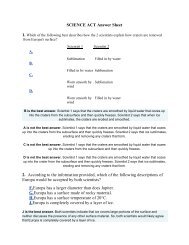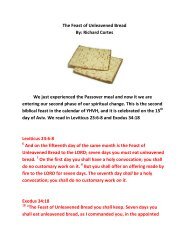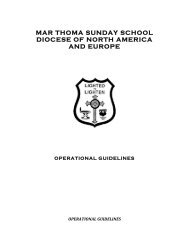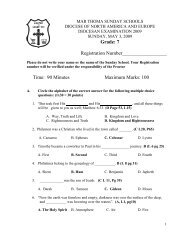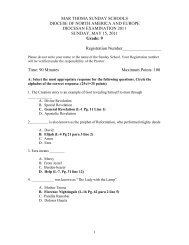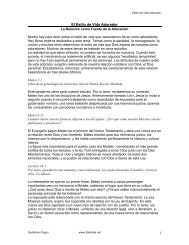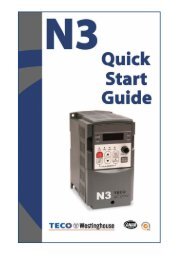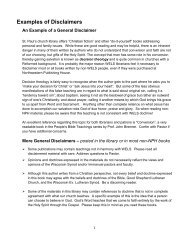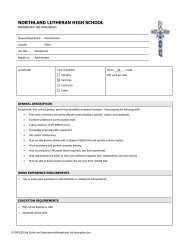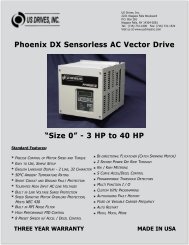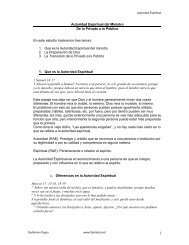MICROMASTERMICROMASTER VectorMIDIMASTER VectorMotor DataMotor Protection:For MICROMASTER Vector and MIDIMASTER Vector thisis realised using PTC thermistors. The PTC thermistor isconnected at the control terminal strip. If the motor protectionfunction is activated (parameter P087 = 1), the driveconverter is shutdown if a high signal level is present at thePTC input (fault code F004 is displayed).For MICROMASTER this is achieved using a digital input asan external trip signal, together with a PTC and additionalresistor. Please see the operating instructions for furtherdetails.Connecting Motors Through LongerFeeder Cables:Long feeder cables between the motor and drive converter orseveral parallel motor feeder cables (group drives), result inadditional re-charging currents due to the cable capacitance.The drive converters must also supply these additionalcurrents. This can activate the drive converter current limitingand cause the unit to shutdown with an "overcurrent" faultmessage (F002).Further, when fed from PWM drive converters with long motorfeeder cables, voltage spikes at the motor can occur due tovoltage reflections.Depending on the drive converter supply voltage, motor framesize and cable length between the motor and drive converter,output reactors or dV/dt filters are required and/or larger driveconverters must be selected.Further, to reduce the cable capacitance, a higher cablecross-section should be used (for MICROMASTER up to 3kW: 2.5 mm 2 , up to 5.5 kW: 4 mm 2 ; for MIDIMASTER up to5.5 kW: 6 mm 2 , up to 15 kW: 10 mm 2 , for MD 1500/2: 16mm 2 , up to 22 kW, 16 mm 2 , up to 37 kW, 25 mm 2 ).For MICROMASTER, it is generally more favorable to select ahigher-rating drive converter than to use an output reactor ordV/dt filter (see Section 3.7).For cable lengths up to 125 metres, it is sufficient to use thenext largest MICROMASTER or MIDIMASTER; up to 200metres, the next but one largest (i.e. 2 steps higher).The output reactor ordering data is specified inSection 6 - Options. In this case, the maximum permissibleoutput frequency is 120 Hz at a maximum switchingfrequency of 4 kHz.The internal I²t calculation also allows the motor to bethermally monitored. Various motor-output de-rating curvescan be parameterised (P074), which limits the motor currentas a function of the frequency, and provides an alarm (P931 =5; motor overtemperature - MICROMASTERVector/MIDIMASTER Vector only).The "alarm" and "fault" signals can also be output via thebinary outputs.1MJ6 motors include PTC thermistors, which are integratedinto the stator winding. If 1MJ6 motors are to be connected todrive converters, then, just like the 1LA5 and 1LA6 motorshaving the same output, the maximum permissible torquemust be reduced.1MJ6 motors have, as standard, a terminal box with degree ofprotection increased safety "e" (EEx e). Voltage peaks canoccur at the motor when fed from a PWM converter if longmotor feeder cables are used due to voltage reflection. Theterminal boxes, degree of protection EEx e are only permittedfor the following maximum voltage peaks due to the air andcreapage distances:• Up to frame size 225M (660 V terminal boxes) for voltagepeaks up to 1078 V.• From frame size 250M (100 V terminal boxes) for voltagepeaks up to 1633 V.In order that these maximum permissible voltage peaks arenot exceeded at the terminal boxes, the following conditionsshould be observed:230 V supply voltage:When using 1MJ motors (EEx e terminal boxes) norestriction.400 V supply voltage:- Only possible when using the standard 4 kHz switchingfrequency.- Output reactor and flameproof terminal boxes (k53) or:dV/dt filter.460 V to 500 V supply voltage:- Only possible when using the standard 4 kHz switchingfrequency.- dV/dt filter.Operating Motors with Degree ofProtection "d":Siemens 1MJ6 squirrel cage motors can be operated fromthe line supply (direct on-line) as well as from a driveconverter, as explosion-protected motors with flameproofenclosure "d". The flameproof enclosure ensures explosionprotection for the drives. The Physikalisch-TechnischeBundesanstalt (German regulatory body) has issued ageneral certificate of conformance for converter operation ofthese motors. 1MJ6 motors include PTC thermistors, whichare integrated into the stator winding. If 1MJ6 motors are tobe connected to drive converters, then, just like the 1LA5 and1LA6 motors having the same output, the maximumpermissible torque must be reduced.7/2 Siemens DA 64 – 1998/99 (04/99)
MICROMASTERMICROMASTER VectorMIDIMASTER VectorMotor Data575 V supply voltage:- Only possible when using the standard 4 kHz switchingfrequency.- Flameproof terminal boxes (K53).- dV/dt filter.Note:For 1MJ motors, PTC thermistors and tripping devices (referto Catalogue NS2) are specified. Code for installing PTCthermistors in the motor:A15 for tripping 1MJ motorsA16 for alarm and tripping 1MJ motors.7.2 Motor - Drive ConverterAssignmentThe induction motors assigned in tables on Page 6/7 andonwards guarantee an optimum utilisation of the motor anddrive converter.7.2.1 Rated Motor Current Greater than theRated Drive Converter CurrentIf the drive is to have a larger motor than that specified in theassignment tables (e.g. if the drive is to be exclusivelyoperated in the partial-load range), then the following limitshould be observed:The maximum drive converter current (short-time current)should be greater than or at least the same as the ratedmotor current of the connected motor or, if applicable, thesum of the rated motor currents of the connected motors (formulti-motor drives).Otherwise, the peak currents which can occur could causethe drive to be tripped due to overcurrent, as the leakageinductance and therefore the current ripple is higher for largermotors.7.2.2 Fan and Pump Drives with 1LA5, 1LA6and 1LA7 Motors: ("Variable Torque", VT)For MIDIMASTER, when the quadratic voltage-frequencycharacteristic (P077 = 2) is used, a significantly highercontinuous current is possible, so that in almost all cases therated output is achieved with the next largest motor ("VariableTorque", VT).Thus, for any specified output, fan and pump drives can use asmaller drive converter.7.2.3 Information regarding the tablesThese tables allow a drive package consisting of motor andinverters to be quickly selected. 2-, 4-, 6- and 8-pole inductionmotors and rated motor voltages of 230 V, 400 V and 500 Vat 50 Hz are listed. This is based on the fact that the motorsare utilised according to temperature rise class F, andcontinuous operation S1. The tables only cover single-motordrives with operation in the constant-flux range. For specialapplications, the motor currents must be individuallydetermined, and then the drive converter selected (e.g. forgroup drives, field-weakening operation or high overload).The shaft output P list specified in the tables refers to the ratedspeed n n of the particular motor. The permissible S1 torque inthe appropriate speed range (for constant-torqueapplications), and at the appropriate speed point (for fan andpump applications), is obtained as follows:P list:nn:MpermissiblePlist⋅9550= in Nmnshaft output in kW at n n specified in the tablerated motor speed in RPMAt the time of writing, Siemens 1LA5/1LA2 motors are due tobe replaced with 1LA7 motors. Please check with your salesrepresentatives which motors are currently available in 1LA7construction.In the following tables, the last digit of the motor ordernumber (shown as a “.”) is for the type of construction. Pleasesee M1 catalogue.nFan and pump drives with load characteristic M ∼ n 2only require the full torque at rated speed. Generally,increased starting torques for load surges are notencountered. Thus, the inverter requires no overloadcapability.For fan and pump drives, the motors and converters areassigned in the tables, so thatThe motor current at full torque at the rated operating point isless than or equal to the continuous drive converter current.The favourable pulse pattern allows, in almost all situations atthe rated operating point, the same shaft outputs as for linesupply operation (direct online), if the motors are utilisedaccording to temperature rise class F.Siemens DA 64 – 1998/99 (04/99) 7/3




